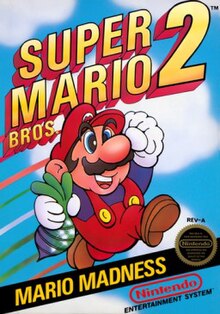
Back سوبر ماريو برذرز 2 Arabic سوبر ماريو بروس 2 ARZ Super Mario Bros. 2 Byelorussian Super Mario Bros. 2 Catalan سووپەر ماریۆ برۆس ٢ CKB Super Mario Bros. 2 German Super Mario Bros. 2 Greek Super Mario Bros. 2 Spanish Super Mario Bros. 2 Estonian برادران سوپر ماریو ۲ Persian
| Super Mario Bros. 2 | |
|---|---|
 North American box art | |
| Developer(s) | Nintendo R&D4 Nintendo R&D2 (GBA) |
| Publisher(s) | Nintendo Fujisankei Communications Group (original Japanese release, as Yume Kōjō) |
| Director(s) | Kensuke Tanabe |
| Producer(s) | Shigeru Miyamoto |
| Designer(s) | Kensuke Tanabe Yasuhisa Yamamura Hideki Konno |
| Programmer(s) | Toshihiko Nakago Yasunori Taketani Toshio Iwawaki |
| Artist(s) | Tadashi Sugiyama Yōichi Kotabe |
| Composer(s) | Koji Kondo |
| Series | Super Mario |
| Platform(s) | Nintendo Entertainment System, Super Nintendo Entertainment System, Game Boy Advance |
| Release | |
| Genre(s) | Platform |
| Mode(s) | Single-player |
Super Mario Bros. 2 is a platform game developed and published by Nintendo for the Nintendo Entertainment System. It was first released in North America in September 1988 and in the PAL region in 1989.
After the smash hit Super Mario Bros. in 1985, Nintendo quickly released a minor adaptation of the original with advanced difficulty titled Super Mario Bros. 2, for its mature market in Japan in 1986. However, Nintendo of America found this sequel too similar to its predecessor, and its difficulty too frustrating, for the nascent American market. This prompted a second Super Mario Bros. sequel based on Yume Kōjō: Doki Doki Panic,[a] Nintendo's 1987 Family Computer Disk System game which had been based on a prototype platforming game and released as an advergame for Fuji Television's Yume Kōjō '87 media technology expo. The characters, enemies, and themes in Doki Doki Panic have the mascots and theme of the festival, and were adapted into the Super Mario theme to make a second Super Mario Bros. sequel.
Super Mario Bros. 2 was a resounding success, becoming the fifth-best-selling game on the NES, and was critically well-received for its design aspects and for differentiating the Super Mario series. It was re-released in Japan for the Famicom as Super Mario USA[b] (1992), and has been remade twice, first included in the Super Mario All-Stars (1993) collection for the Super NES, and as Super Mario Advance (2001) for the Game Boy Advance. It is included as part of the Virtual Console and Nintendo Switch Online services.
Cite error: There are <ref group=lower-alpha> tags or {{efn}} templates on this page, but the references will not show without a {{reflist|group=lower-alpha}} template or {{notelist}} template (see the help page).
© MMXXIII Rich X Search. We shall prevail. All rights reserved. Rich X Search